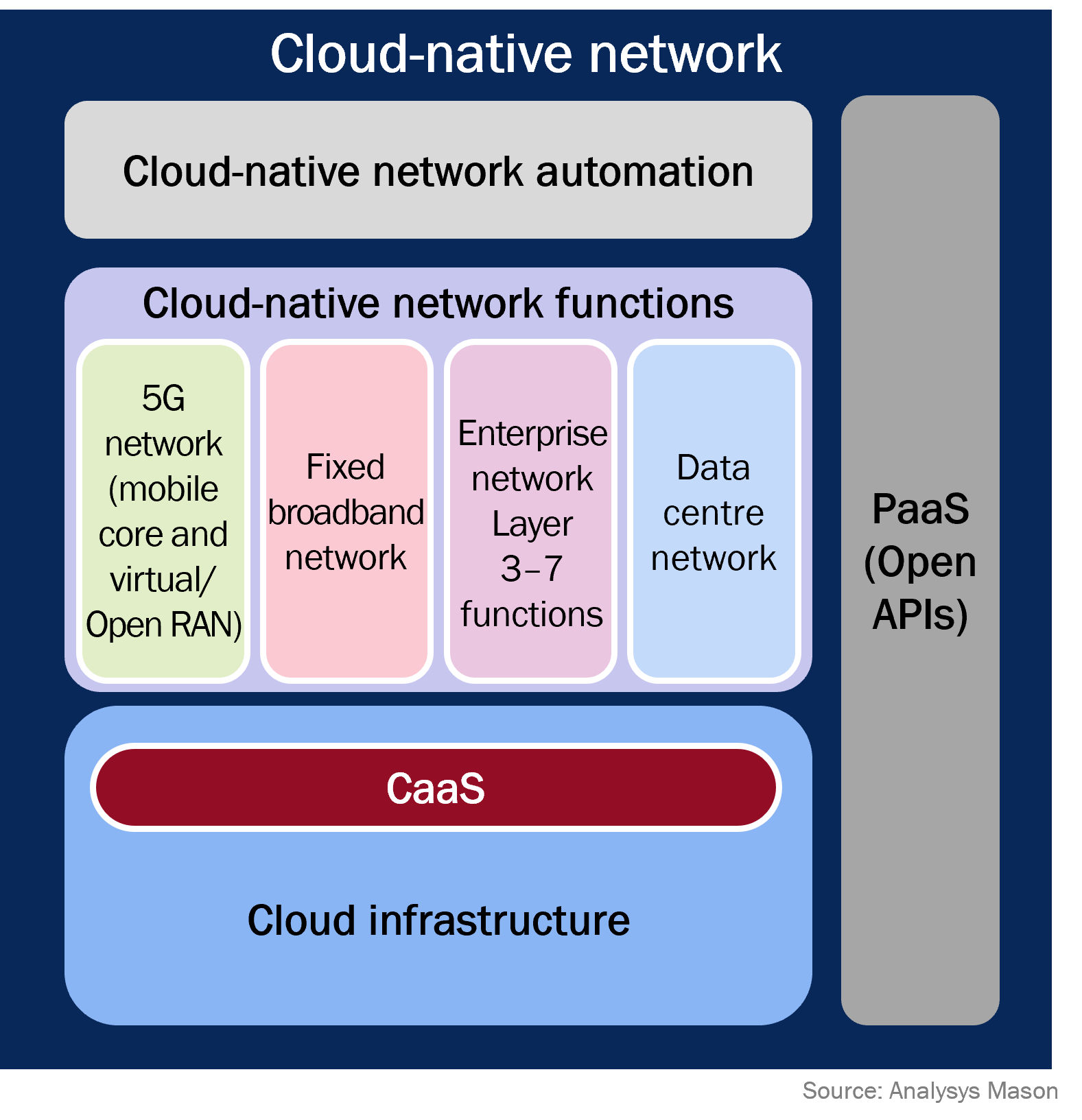Network convergence needs a cloud-native programmable network platform to succeed
The concept of network convergence has been making the news over the past few months. Operators are becoming aware of the fact that they will not be able to deliver network slicing, network-as-a-service (NaaS) and other future services that need to run seamlessly across a network fabric, unless they dismantle the barriers between their network domains. Operators are not particularly clear about what they mean by network convergence. However, in our new report, The programmable, cloud-native network: a target architecture for operators, Analysys Mason argues that a future network will decouple software-based functionality from underlying physical infrastructure across multiple network domains – mobile, fixed, data centre and transport. The network will then use the cloud as the programmable platform on which all network functionalities can converge.
Disaggregation and convergence on a cloud-native platform will have four major benefits. It will enable operators to:
- address new service opportunities faster and more effectively
- make themselves more competitive against new market entrants with greenfield, cloud-native networks
- adopt new cloud-based innovation in a timely manner
- embrace new business models, such as the as-a-service consumption of programmable network platform (PNP) components.
Cloud-native network convergence is nascent, but it promises long-term benefits
Network convergence is difficult to achieve with physical networks, each of which has been built as a silo using different technologies, protocols and operational practices, often for good reasons, but also as a result of historical reluctance to reuse network concepts and components that others have invented. For the past decade, leading operators have been attempting a kind of convergence across physical network silos by building domain-specific network automation and controllers into each of them and then trying to stitch these together through end-to-end orchestration. There are good reasons for this approach. For example, it limits disruption to an operator’s operational and organisational status quo. However, the complexity and cost of different network silos remains underneath. Physical networks are not less complex than software-based ones – the type of complexity is simply different. The more heterogeneity there is between network domains, the more complexity an operator will have to deal with.
In contrast, running network software from multiple network domains on a common, cloud-based infrastructure can massively simplify network operations. Modern cloud-native automation approaches can be applied both to digital (cloud) infrastructures and cloud-native network functions of any type. A cloud platform, by definition, is highly converged, as Figure 1 shows, reducing integration overheads, network footprint and management costs. It is also inherently programmable in a way that the physical network is not. A cloud-based network platform natively supports the API-driven acquisition and composability of network capabilities so it can be upgraded to support new services in an agile and inexpensive ‘fast fail/fast scale’ mode.
Figure 1: Converged architecture of a cloud-native programmable network platform

The first benefit of a PNP is that it supports network convergence. However, further benefits are expected from the convergence of networking with other types of cloud-based applications. This will result from the cross-industry trend to build next generation functionality in software on cloud-based platforms, eventually enabling the ‘world as code’.
It is dangerous to oversimplify – not all network functionalities can run on the cloud so specialist hardware will still be needed to support specific functions. Network cloud infrastructure is in the process of evolving away from a pure x86 architecture that has proven inadequate on its own to support the particular needs of certain network functions. Therefore, cloud infrastructure is likely to become more heterogeneous and complex in the future. However, the largest barrier to cloud-native network convergence remains cultural and organisational. Many operators do not have the vision and/or the appetite for the high levels of disruption this transformation represents, despite the potential benefits.
Operators can build the cloud-native PNP one domain at a time but will need strategic vision and support from senior executives
Although progress towards the network as a cloud-native PNP is slow, it is nevertheless underway. Operators can and are implementing 5G standalone (SA) cores as cloud-based appliances but the most advanced are choosing to deploy this function as a programmable platform. If the monetisation potential of the PNP approach can be proven for 5G, it will encourage other network domains to follow suit. The RAN is already moving in this direction and B2B operators are starting to reimagine their enterprise networks as PNPs. BT’s, Orange’s and Vodafone’s business groups have been vocal in the past year about becoming platform companies. Such operators have yet to bring what appear to be separate PNP developments in different network domains together into a single logical platform, but they are getting closer to achieving this goal as they cloud-natively transform each domain.
If operators are serious about a future-proof approach to network convergence, they need to make the acquisition of a cloud-native PNP a top strategic priority in 2024. Only those operators that lead from the top have shown that they can successfully undertake a cloud-based transformation. Senior level vision and support will be needed to join up PNP developments across siloed network domains for maximum impact on the business. We expect to see an interesting alternative to operators’ internal PNP developments emerge in 2024 as vendors led by Cisco and Nokia offer converged platforms of their own which operators can consume as-a-service. We also anticipate that to thrive as PNP-enabled businesses, operators will need a more-sophisticated product management function than many of them have today. Advanced operators that demonstrate platform thinking are recruiting product management talent to drive new value from the network.
Article (PDF)
DownloadAuthor

Gorkem Yigit
Research DirectorRelated items
Article
NVIDIA GTC Paris 2025: digital twins and sovereign AI signal a new era for telecoms infrastructure
Article
GenAI in the network: who is making real progress, and what is driving it?
Article
Operators are set to invest USD77 billion cumulatively in AI cloud infrastructure between 2025 and 2030

